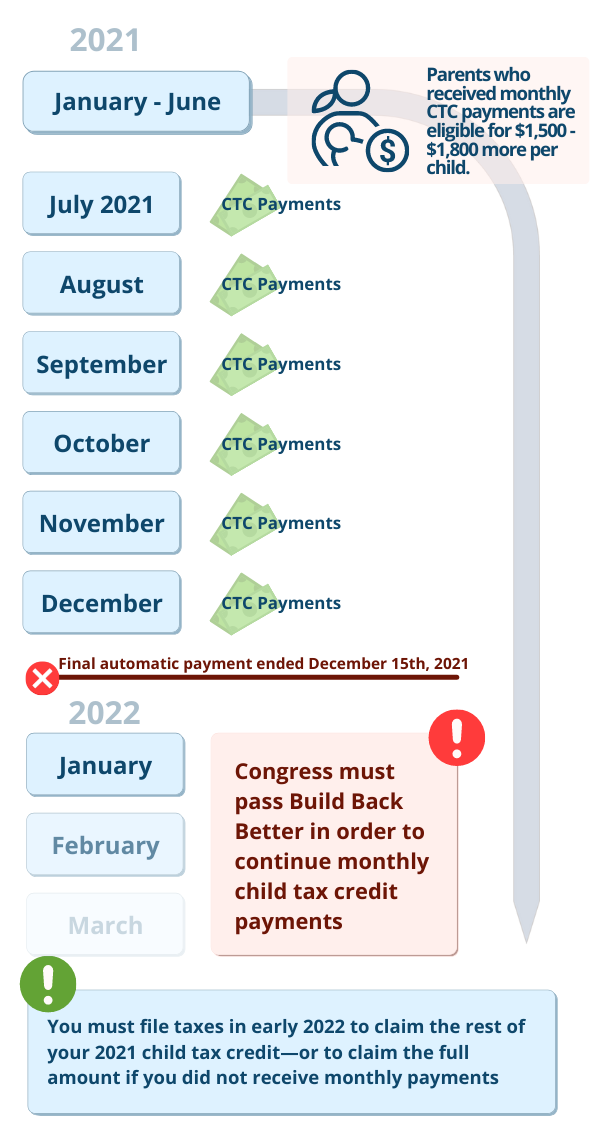What Families Need to Know about the CTC in 2022
This blog was updated on May 24, 2022.
By Ashley Burnside
The temporary expansions to the Child Tax Credit (CTC) dramatically reduced the share of children experiencing poverty in 2021, especially for Black and Latinx kids. The expansions also lowered food insecurity rates, helped families afford necessities, and reduced financial stress for parents. But since the monthly CTC payments ended in December 2021—at least for now—many are left feeling uncertain. Here is what families need to know about the CTC in 2022:
Families with children can still get the rest of their 2021 credits—but only if they file a 2021 tax return or use the Code for America GetCTC tool. Families who got monthly CTC payments in 2021 received six months’ worth of payments (from July through December). To get the remaining half of the credit they are eligible for, they must file a tax return or use the GetCTC simplified filing tool this year. This is true even if a parent made little or no income last year—they are still eligible for the CTC and they must take action to get it.
If a parent is not required to file taxes and they missed the tax filing deadline, they can use the GetCTC simplified filing tool to claim their CTC payment. The online form typically takes about 15 minutes to complete and doesn’t require having any tax documents. (The tool is available in Spanish here.) Parents who opted out of receiving the monthly payments last year using the IRS website will need to file a tax return or use the simplified filing tool to get their entire 2021 CTC payment. Parents should also file their tax return to claim new babies who were born in 2021 or any other children for whom they didn’t get advance payments in 2021. Even if a baby was born as late as December 2021, that baby would still be eligible for the full $3,600 CTC payment when their family files a 2021 tax return. Note that if a family wishes to claim the Earned Income Tax Credit (EITC) for 2021, they need to file a 2021 tax return, rather than using the simplified tool. The EITC can be worth up to $6,728 for a family with 3 or more children.
Families are Eligible for Remaining Child Tax Credit Payments in 2022
If families get a letter from the IRS saying how much they received from the advance CTC, they should keep the letter because it will have important information for filing their 2022 return. The IRS will send Letter 6419 to all families who received the advance CTC payments indicating how many monthly CTC payments they received and how many children in the household were eligible. The IRS will mail the letter to the address it has on file for the family. Families can also log on to the IRS CTC Update portal to look up this information. If the number of the total CTC payments the parent enters on the 2021 tax return doesn’t match what the IRS has on file, this may delay their refund.
Parents or caregivers can receive the portion of the 2021 CTC they have not received by filing IRS Tax Form 1040 or 1040-SR or by using the GetCTC tool. There are several free ways to file taxes online or to receive in-person support from community partners when filing a return. If they got an IRS Letter 6419, they should bring it with them if they are getting in-person help. Some options for tax assistance include:
- IRS Free File (available to people whose income was $72,000 or less in 2021);
- IRS’s Volunteer Income Tax Assistance (VITA) (generally available to people who make $57,000 or less, those who have disabilities, and those who speak limited English);
- MyFreeTaxes; and
- GetYourRefund.
The CTC payment that families will get when they file their tax return may be reduced to pay back other taxes or debt they owe. When a caregiver files a 2021 tax return, the lump sum CTC payment will be subject to possible tax offsets, meaning a refund could be reduced to pay for tax debts or other federal or state debts the tax filer owes, such as overdue child support payments. (The 2021 monthly advance CTC payments were protected from being reduced in this way.) Tax refunds can also be intercepted to repay student loans; however, since the Biden Administration extended the federal student loan repayment moratorium until August 31, 2022, this debt should not be an issue for most people. The U.S. Department of Education has also announced it will not seize CTC payments for past-due student loans. The tax refund will not be protected from garnishments by private debt collectors. You can learn more about this on the IRS website.
Getting the CTC payments will not impact families’ immigration status or eligibility for other programs that help them meet their basic needs. If families receive the CTC lump-sum payment in their 2021 tax return, that will not impact their eligibility for other programs like the Supplemental Nutrition Assistance Program (SNAP), Medicaid, or Supplemental Security Income (SSI). Receiving the CTC payments also will not impact their immigration status, their ability to get a green card, or a family’s immigration plans. And receiving the CTC is not considered in determining whether an immigrant will be a “public charge.” (You can learn more about CTC eligibility for mixed-immigration-status families here.)
Unless lawmakers pass extensions to the CTC expansions, there will not be any more monthly CTC payments. Despite the benefits that the CTC expansions have had for families across the country, Congress has not extended the expansions beyond 2021. The Build Back Better (BBB) Act would have extended the CTC expansions for an additional year (through 2022) and made the CTC permanently available to families making little or no income. This would have disproportionately benefitted Black and Latinx children. But Congress still needs to pass legislation to put these changes into effect.
Caregivers should contact their members of Congress and tell them how the CTC payments have helped their families, and encourage lawmakers to pass an extension of these critical payments. Congress must help families afford necessities through passing an economic package in 2022.

